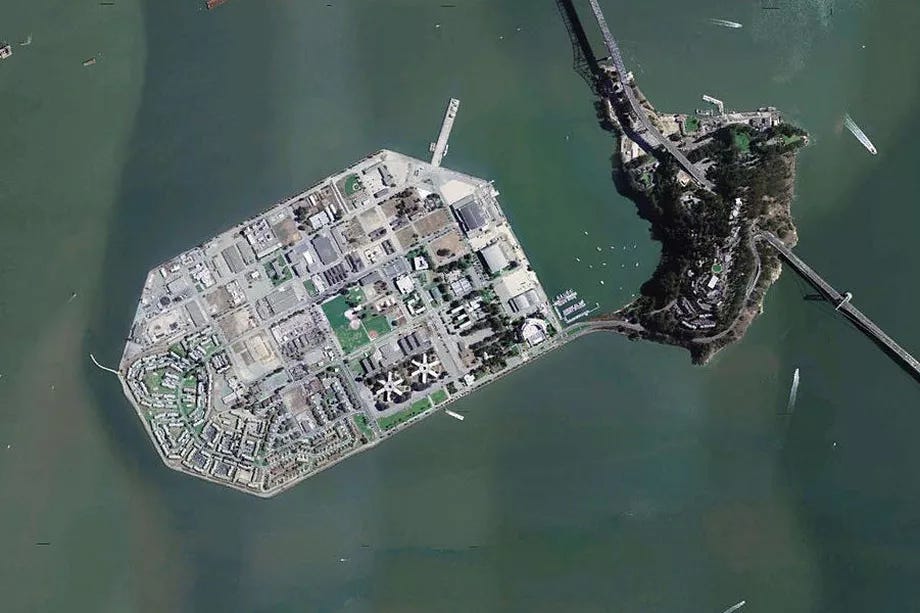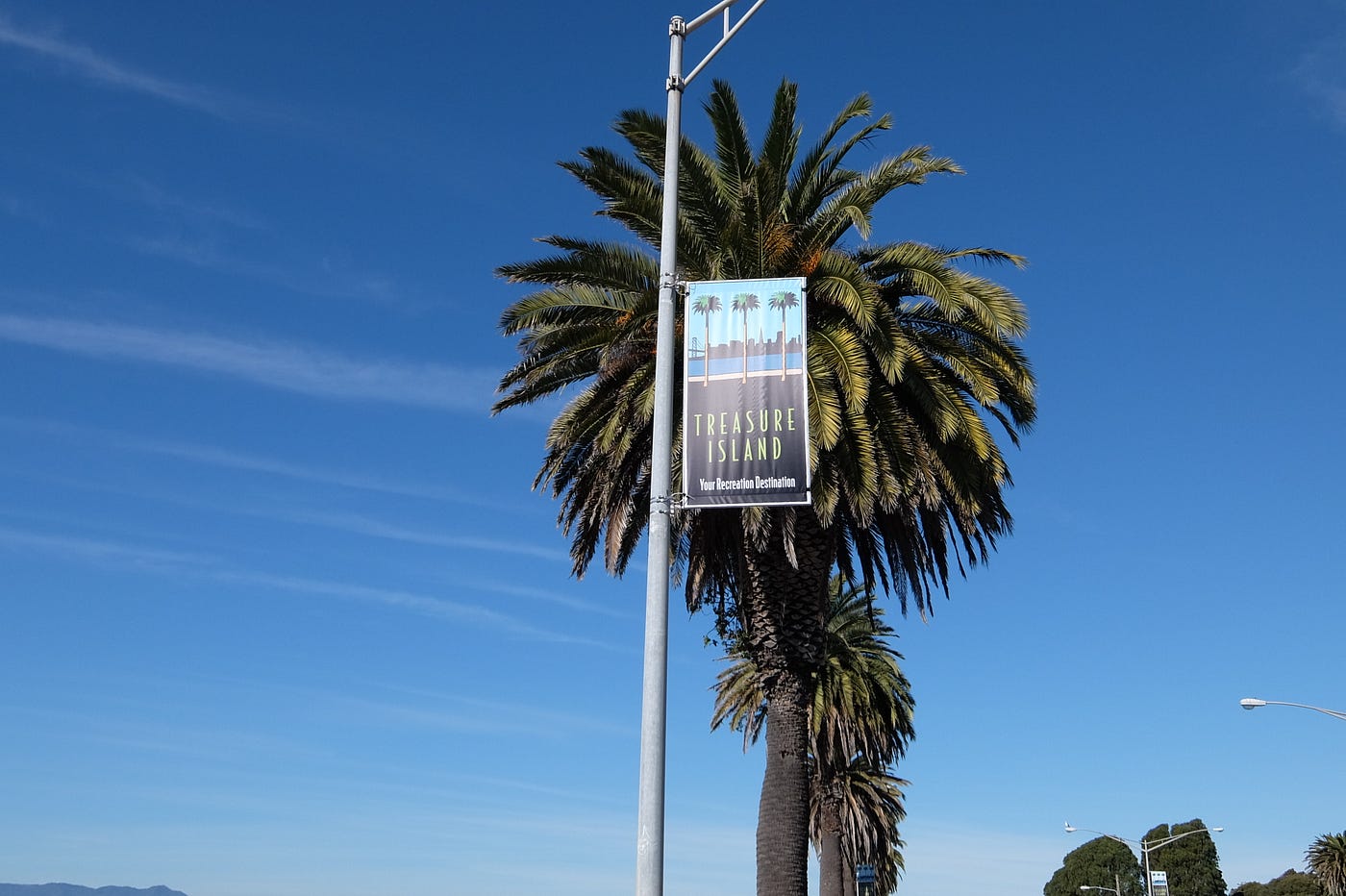
Is there anywhere more strange and mysterious than Treasure Island? Sandwiched between San Francisco and the East Bay, the 5,500-by-3,400 manmade hunk of dirt is known for its boarded-up buildings, weird radioactive history, amazing views, new urban wineries and the tight-knit community of 3,000 folks who call it home. On top of this, it’s served as a stalwart place for the homeless since the early 1990s.
Developers have been itching to build on the island for years but have been put off due to a combination of a statewide rollback in redevelopment funding and a lengthy series of lawsuits around the California Environmental Quality Act. But now, after years of lusting, they’re finally getting their chance: a $5 billion redevelopment project is officially underway.
In the end, the island will get $50 million in public artwork, 8,000 new housing units, at least three hotels, various public parks and 140,000 square feet of new retail and commercial space. The currently desolate space — with no ATMs and one place at which to shop for food — will be virtually unrecognizable in 10 to 15 years.
What all of this means is that the Bay Area, squeezed beyond capacity, will have a chance to create a community from scratch and make a dent in the area’s housing and homelessness crises. It’s a massive opportunity that can’t be wasted.
Several nonprofit groups are planning ways to provide for homeless residents amid the massive changes, but some in the advocacy community fear efforts will fail to go far enough to generate effective change beyond the island.
Treasure Island has been involved in the homelessness crisis since 1994, when what was then an administrative naval base was turned over from the federal government to the city of San Francisco. Legislation required the city to use the land partially to support homeless individuals.
Soon after, the Treasure Island Homeless Development Initiative (TIHDI) established a consortium of community organizations to oversee that work, including Catholic Charities, Mercy Housing and HealthRIGHT 360. In 1999, about 85 homeless individuals moved onto the island into renovated homes formerly inhabited by Navy families.
“Homelessness efforts are baked into the redevelopment plan and have been for 25 years,” said Sherry Williams, executive director of One Treasure Island, the new moniker for TIHDI.

Since that time, the number of homeless people living on the island has risen to about 600 living in 286 units. Catholic Charities manages 250 apartments nested within six-plex and eight-plex buildings that serve as permanent supportive housing, and HealthRIGHT 360 offers up 36 two-bedroom units as transitional housing.
While it’s clear that homeless advocacy has been a crucial component of the island so far, will that continue as thousands of wealthy new residents move in?
Nonprofits also offer Treasure Island residents financial-assistance programs, job training and direct job-placement opportunities. Through the Job Broker System, One Treasure Island places economically disadvantaged community members in about 25 percent of all job openings in addition to free job-skill seminars like résumé writing, job-search support and one-on-one credit counseling.
While it’s clear that homeless advocacy has been a crucial component of the island so far, will that continue as thousands of wealthy new residents move in?
One Treasure Island says yes. It plans to capitalize on the attention and funding the island is receiving to go bigger with its efforts. But when you look at the numbers, housing for the homeless is actually a very small percentage of what’s going up on the island.
Out of the 8,000 planned new units, roughly 2,000 will be set aside affordable housing or shelters for the homeless.The vast majority will be reserved for those making 50–60 percent of the area’s median income (about $41,450 to $49,750 for a one-person household).
Any number of new, additional supportive housing spaces is helpful, but given the magnitude of the homelessness crisis, many feel 185 new spaces will be woefully insufficient to make an impact felt across the Bay Area.
Out of those 2,000 units, 435 will be used for the homeless—250 replacing homes currently serving as permanent supportive housing for the homeless on the island and 185 guaranteed new spaces for homeless individuals and families.
Of course, any number of new, additional supportive housing spaces is helpful, but given the magnitude of the homelessness crisis, many feel that 185 new spaces will be woefully insufficient to make an impact felt across the Bay Area.
One such person who believes those numbers are too low, given the guidelines established by the San Francisco Mayor’s Office, is Jennifer Friedenbach, executive director of the Coalition on Homelessness.
“Twenty percent of the units for homeless people is the very lowest number that should be included in any development, and this is under that. Ideally, the proportion would be closer to 40 percent,” she said.
As it’s planned now, affordable housing will be at 25 percent of the project, but total housing reserved for the homeless is only 435 units—just over 5 percent.
Why not go bigger? The issue, as always, comes down to funding—or a lack of it. As a result, the redevelopment project will likely prove to be beneficial for homeless people already living on the island but will fall short for communities that live beyond its boundaries.

For example, the first set of mixed-income buildings is projected to cost $100 million. The Mayor’s Office has provided the first $2 million in predevelopment funding, but the rest is still pending.
“You could put forward every perfect plan, with everybody being supportive, but if you don’t literally have the money to build, then every plan is worth as much as the piece of paper that it’s written on,” Williams said.
Barbara Gualco, director of real estate development at Mercy Housing California, agrees, saying that construction costs have escalated to “unprecedented rates,” forcing them to find local subsidies to make it work.
Nonprofit-housing developers like Mercy Housing are using a variety of sources to get the job done, including support at the state level and money generated from municipal bond measures allocated to affordable housing. Unfortunately, this won’t include funds generated from Proposition C, the homelessness initiative that passed in November’s election.
Even if some insist that more units should be available for low-income and homeless people, one of the features developers are most proud of is the integration of these individuals and families, Williams explained.
“There’s going to be affordable housing projects right next to market-rate for-profit housing,” she said. “There will also be levels of affordability, so very low-income, formerly homeless folks will be living with people of higher, affordable rents.”
This mixed arrangement has become a standard for San Francisco affordable housing projects. Developers must set aside 17–20 parcels for buildings of this kind.
“Housing on Treasure Island would not be appropriate for many individuals.”
In addition, they’re excited about how the beauty of the setting might affect people.
“The island is incredibly therapeutic,” Gualco said. “What we’ve learned in supportive housing work is that really creating beautiful living environments that are modest, but in beautiful settings, can help people get back to realizing what they want to do.”
While there’s no doubt that Treasure Island offers some of the most beautiful views in the world, how practical is it when it comes to homeless people receiving services that may be located elsewhere in the Bay Area?
Heather Freinkel, managing attorney at the Homeless Action Center, said that her clients suffer from severe disabilities that require easier access to medical and legal resources that don’t exist on the isolated island.
“Housing on Treasure Island would not be appropriate for many individuals,” she said.
Perhaps the biggest benefit that the redevelopment of Treasure Island will have on the Bay Area’s homeless population is job opportunities.
The full build-out of the island will take an estimated 10–15 years, and in that time, hundreds of construction jobs will open up that One Treasure Island plans to train homeless community members to fulfill.
“Our construction training program is definitely going to expand,” said Williams, explaining that wages earned through construction positions combined with free financial counseling services can be enough to lift someone out of poverty.
The organization also hopes to connect residents to tourism-related jobs, including at bike rentals, cafe kiosks, visitor centers, the Treasure Island Museum and the Treasure Island Sailing Center.
In the end, it’s clear that Treasure Island has the potential to be an exceptional large-scale San Francisco neighborhood in a decade’s time—one that offers more than another shiny, gentrified piece of land but that actually brings relief to a region that so desperately needs it. Here’s to hoping that it lives up to that opportunity.
*An earlier version of this article quoted Heather Freinkel as saying “Living on Treasure Island would simply not be appropriate for many individuals.” The correct quote is “housing on Treasure Island would not be appropriate for many homeless individuals.”







